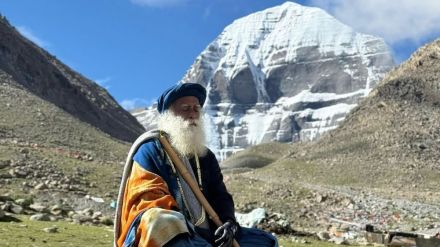Recovering from any surgery takes time. But when it comes to brain surgery, one needs to be extra cautious. However, spiritual leader Sadhguru Jaggi Vasudev chose to do totally the opposite. Sadhguru underwent two brain surgeries in 2024, and has chosen a very different path. At 67 he took on the challenging route to Mount Kailash, not by car or plane, but on his bike. In a recent conversation with actor R Madhavan, the actor asked him what inspired such a risky journey.
“When most people would be playing it really safe, you decide to go to Mount Kailash, not via a normal route but by bike, most perilous journey in the rain and mud, what made you do this?” Madhavan asked. Sadhguru, who is recovering from a subdural hematoma, laughed and replied, “When the head is broken, I thought it’s best to put it in Shiva’s lap.” Impressed by his fearless response, Madhavan said, “What a wonderful attitude.”
Sadhguru revealed that he has been visiting Kailash for many years, though recent restrictions limited him to the Lake Mansarovar side. “I missed last year because I had a broken head. I broke it twice, not once,” he said.
He also recalled visiting Kailash in a weakened state after losing nearly one-fourth of his thigh muscle mass in just 12 weeks. “But in that condition, I came to Kailash and I sat there,” he said, underlining his determination.
Sadhguru further shared how his second surgery came about. While swimming with his daughter, he was attacked by a monkey, crashed into a glass door, and cracked his head. Despite severe brain bleeding, he continued his schedule for three days before undergoing another emergency surgery.
What is Subdural Hematoma?
A subdural hematoma is a serious medical condition where blood collects between the brain’s surface and its outer covering (the dura). This bleeding usually happens after a head injury and can put dangerous pressure on the brain.
According to the Mayo Clinic, symptoms may include headaches, confusion, dizziness, nausea, slurred speech, or even loss of consciousness. In severe cases, it requires emergency surgery to relieve the pressure and prevent permanent brain damage.
The risks of such adventures
But after undergoing brain surgery, what are the risks of engaging in such physically demanding activities?
Dr Jagadish Hiremath, public health intellectual, told The Indian Express, “Following brain surgery, the body takes time to heal and regain balance in terms of neurological and physical strength. Activities such as long bike rides or high-altitude treks place additional stress on the body because they involve physical endurance, fluctuating oxygen levels, and potential strain on the brain’s recovery.”
He explained that risks include dizziness, fatigue, imbalance, and even an increased vulnerability to head injuries if a fall occurs. These activities can only be considered after recovery has stabilized, and even then, strictly under medical guidance.
Beyond medical care, psychological resilience can make a difference. Dr Hiremath told The Indian Express, “A positive outlook can influence the body’s healing response, improve adherence to treatment, and enhance overall well-being. While medical care is fundamental, a determined mindset creates a supportive environment for the body to heal and regain strength.”
How to stay active safely after brain surgery
For patients who want to remain active, doctors advise taking small, safe steps first. Gentle physical activities like walking, stretching, or light yoga under supervision can help maintain mobility without overexertion.
“Maintaining a balanced diet, staying hydrated, and getting enough rest are equally important,” Dr Hiremath told The Indian Express. “Avoid sudden altitude changes or high-risk activities until cleared by a doctor. Regular follow-ups with a neurologist and physiotherapist are essential to ensure progress is monitored and activity levels are increased safely,” he further explained to The Indian Express.
